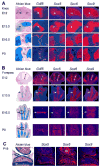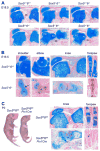Synovial joint morphogenesis requires the chondrogenic action of Sox5 and Sox6 in growth plate and articular cartilage
- PMID: 20206616
- PMCID: PMC2862098
- DOI: 10.1016/j.ydbio.2010.02.024
Synovial joint morphogenesis requires the chondrogenic action of Sox5 and Sox6 in growth plate and articular cartilage
Abstract
The mechanisms underlying synovial joint development remain poorly understood. Here we use complete and cell-specific gene inactivation to identify the roles of the redundant chondrogenic transcription factors Sox5 and Sox6 in this process. We show that joint development aborts early in complete mutants (Sox5(-/-)6(-/-)). Gdf5 and Wnt9a expression is punctual in articular progenitor cells, but Sox9 downregulation and cell condensation in joint interzones are late. Joint cell differentiation is unsuccessful, regardless of lineage, and cavitation fails. Sox5 and Sox6 restricted expression to chondrocytes in wild-type embryos and continued Erg expression and weak Ihh expression in Sox5(-/-)6(-/-) growth plates suggest that growth plate failure contribute to this Sox5(-/-)6(-/-) joint morphogenesis block. Sox5/6 inactivation in specified joint cells and chondrocytes (Sox5(fl/fl)6(fl/fl)Col2Cre) also results in a joint morphogenesis block, whereas Sox5/6 inactivation in specified joint cells only (Sox5(fl/fl)6(fl/fl)Gdf5Cre) results in milder joint defects and normal growth plates. Sox5(fl/fl)6(fl/fl)Gdf5Cre articular chondrocytes remain undifferentiated, as shown by continued Gdf5 expression and pancartilaginous gene downregulation. Along with Prg4 downregulation, these defects likely account for joint tissue overgrowth and incomplete cavitation in adult mice. Together, these data suggest that synovial joint morphogenesis relies on essential roles for Sox5/6 in promoting both growth plate and articular chondrocyte differentiation.
Copyright 2010 Elsevier Inc. All rights reserved.
Figures







Similar articles
-
Mechanisms of synovial joint and articular cartilage development.Cell Mol Life Sci. 2019 Oct;76(20):3939-3952. doi: 10.1007/s00018-019-03191-5. Epub 2019 Jun 14. Cell Mol Life Sci. 2019. PMID: 31201464 Free PMC article. Review.
-
The transcription factors SOX9 and SOX5/SOX6 cooperate genome-wide through super-enhancers to drive chondrogenesis.Nucleic Acids Res. 2015 Sep 30;43(17):8183-203. doi: 10.1093/nar/gkv688. Epub 2015 Jul 6. Nucleic Acids Res. 2015. PMID: 26150426 Free PMC article.
-
L-Sox5, Sox6 and Sox9 control essential steps of the chondrocyte differentiation pathway.Osteoarthritis Cartilage. 2001;9 Suppl A:S69-75. doi: 10.1053/joca.2001.0447. Osteoarthritis Cartilage. 2001. PMID: 11680692
-
Evolutionarily conserved, growth plate zone-specific regulation of the matrilin-1 promoter: L-Sox5/Sox6 and Nfi factors bound near TATA finely tune activation by Sox9.Mol Cell Biol. 2011 Feb;31(4):686-99. doi: 10.1128/MCB.00019-10. Epub 2010 Dec 20. Mol Cell Biol. 2011. PMID: 21173167 Free PMC article.
-
Transcriptional mechanisms of chondrocyte differentiation.Matrix Biol. 2000 Sep;19(5):389-94. doi: 10.1016/s0945-053x(00)00094-9. Matrix Biol. 2000. PMID: 10980415 Review.
Cited by
-
Lgr5 and Col22a1 Mark Progenitor Cells in the Lineage toward Juvenile Articular Chondrocytes.Stem Cell Reports. 2019 Oct 8;13(4):713-729. doi: 10.1016/j.stemcr.2019.08.006. Epub 2019 Sep 12. Stem Cell Reports. 2019. PMID: 31522976 Free PMC article.
-
Mechanisms of synovial joint and articular cartilage development.Cell Mol Life Sci. 2019 Oct;76(20):3939-3952. doi: 10.1007/s00018-019-03191-5. Epub 2019 Jun 14. Cell Mol Life Sci. 2019. PMID: 31201464 Free PMC article. Review.
-
Blocking calcium-MYC regulatory axis inhibits early dedifferentiation of chondrocytes and contributes to cartilage regeneration.Stem Cell Res Ther. 2025 Jul 15;16(1):372. doi: 10.1186/s13287-025-04483-3. Stem Cell Res Ther. 2025. PMID: 40660304 Free PMC article.
-
Transcriptional control of chondrocyte specification and differentiation.Semin Cell Dev Biol. 2017 Feb;62:34-49. doi: 10.1016/j.semcdb.2016.10.004. Epub 2016 Oct 19. Semin Cell Dev Biol. 2017. PMID: 27771362 Free PMC article. Review.
-
SOX11 contributes to the regulation of GDF5 in joint maintenance.BMC Dev Biol. 2013 Jan 29;13:4. doi: 10.1186/1471-213X-13-4. BMC Dev Biol. 2013. PMID: 23356643 Free PMC article.
References
-
- Akiyama H. Control of chondrogenesis by the transcription factor Sox9. Mod Rheumatol. 2008;18:213–219. - PubMed
-
- Amarilio R, Viukov SV, Sharir A, Eshkar-Oren I, Johnson RS, Zelzer E. HIF1alpha regulation of Sox9 is necessary to maintain differentiation of hypoxic prechondrogenic cells during early skeletogenesis. Development. 2007;134:3917–3928. - PubMed
-
- Bergstein I, Eisenberg LM, Bhalerao J, Jenkins NA, Copeland NG, Osborne MP, Bowcock AM, Brown AM. Isolation of two novel WNT genes, WNT14 and WNT15, one of which (WNT15) is closely linked to WNT3 on human chromosome 17q21. Genomics. 1997;46:450–458. - PubMed
Publication types
MeSH terms
Substances
Grants and funding
LinkOut - more resources
Full Text Sources
Molecular Biology Databases
Research Materials
Miscellaneous

